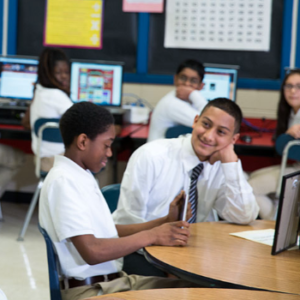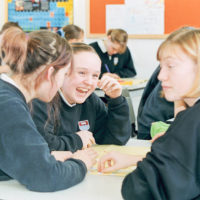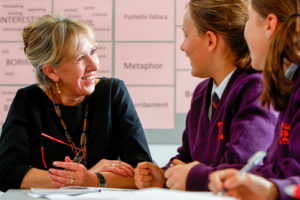Few secondary schools benefit from an intake of students who are well-versed in their Learning Powers i.e. those learning dispositions that determine their propensity for change and will influence and underpin their performance throughout life. Sadly, despite a rapid uptake of learning power ideas in primary schools ten and more years ago, few have persevered with a rich approach to developing learning behaviours. This has meant that while some pupils are familiar with the vocabulary of learning power, very few can extend to the ultimate goal of being able to select and use learning power strategies in order to become better learners. Those relatively few pupils who have become fluent in using and improving their learning dispositions, often find that their learning power is stifled in secondary schools because curriculum delivery doesn’t give them the freedom to use those behaviours.
And so it is that the introduction of learning how to learn in secondary schools needs to encompass a large number of students with potentially diverse views of themselves as learners, split across a wide variety of groupings that change frequently throughout the day. How have schools tackled this difficult job of introducing students to their learning dispositions?

Firstly the “don’t dos”
Experience has suggested that two, seemingly straightforward, approaches don’t work and should be avoided at all costs:
1) Assuming that your students will somehow pick up both the why and the how of these learning behaviours simply because they are exposed to them, somewhere across the curriculum, through everyday teaching. They do not. Learning behaviours need to be brought out of the shadows. They need to be given a name, shown to be important, given opportunities to grow, talked about, reflected on and appreciated as developing aspects of their learning character. Without such determined nurturing it’s easy to find, for example, group work involving 15 year olds that shows no improvement on that of 7 year olds. Repeated opportunities to work ineffectively with others consolidates unhelpful learning behaviours rather than improving them.
2) A one-day special about learning in September, to get it out of the way, before the ‘real stuff ‘ starts, i.e. content delivery. Experience has shown that a swift one-day event usually leads to cognitive overload and shut down in students. There isn’t enough time for students to grasp the complex business of learning, try out opportunities to experience new approaches to learning and begin to undo some unhelpful behaviours that they may have acquired. That said, such a one-day launch before a longer Learning how to Learn course has been found to be useful.
A free standing Learning how to Learn course.
Some schools have introduced Learning how to Learn (Lhow2L) in a free-standing course. Such courses are designed to introduce students to what learning is about but the course itself is part of a holistic strategy of introducing learning power across the school. Such strategies are often divided into three elements:
- Staff and students benefit from an initial day in which they are introduced to the why and how of learning habits.
- The introductory day is followed by the Lhow2L course using specific timetabled lessons over a term or two and designed to give students deeper background knowledge about how they learn and, over time, to become aware of using their learning habits and how. This serves to relieve subject teachers of having to explain the background to the approach; 50 minute lessons don’t allow time to cover background thinking to the “how” as well as the ‘what’ of the subject.
- Use of learning habits is integrated into ever widening aspects of the school’s curriculum. It has proved essential to translate the key points from the initial day into practice in the school: unless the ideas are ‘lived’ in the classroom, they will remain just that – ideas.
Things to think about:
- The Learn 2 Learn course needs curriculum time – but where will this come from? What else is sacrificed?
- It needs designing – by whom? Who are in a position to do this well.
- It needs to be taught – by whom?
- It needs to impact on subject delivery – how will this be achieved? How are teachers going to adapt their practice?
Curriculum Time: A school can do anything it wants, but it can’t do everything it wants. If time is devoted to a Lhow2L course, that is time that cannot be used elsewhere. If Lhow2L has curriculum time, something else misses out. It’s a question of where the school puts its priorities. Schools that have explored the value of a L2L course find it works best when timetabled into Year 7 and possibly Year 8, sometimes with a refresher at the beginning of Year 12. In KS3, one hour per week is the most common time allocation. Curriculum time needs to be sufficient for learners to explore, experience, reflect on and talk about the learning behaviours that the school wishes to introduce.
Course design: The course is best designed by the team of teachers who will be delivering it; interested lead teachers/senior teachers generally take on this leadership/design role. Planning for the L2L course has to be synchronised with how the school is planning to take up the approach across the curriculum. Course designers need to be sufficiently knowledgeable about learning power to design a programme that supports the school’s learning intentions. Consistency of approach is critical so that students get the same messages in the L2L course at broadly the same times as they experience them in the classroom (see Impact, below). As a consequence, teachers delivering the course need to deliver it as planned. Many a L2L course has been derailed by enthusiastic trainers trying out their own ideas which didn’t coincide with those being displayed, tried out and experienced in classrooms.
Delivery: Who delivers the Lhow2L course is of critical importance, not only for the quality of what is delivered, but for the messages it sends about the school’s commitment to developing students’ Learning Power. Giving it to a few teachers with a gap on their timetable is almost guaranteed to fail, for the all too obvious reasons. Delivery has to rest, certainly in the first couple of years, with the lead teachers and senior teachers who are spearheading the development overall.
How the course is delivered is of equal importance. The temptation to ‘teach’ learners about learning must be resisted. Delivery should focus on helping learners to learn about their own learning powers. It follows that learning will be experiential, and coaching rather than telling will be key. It is about unlocking learners’ understanding of the learning powers they do and could command.

Impact on subject delivery: This aspect is absolutely essential: subject teachers will need to understand that they are an integral part of the Lhow2L course. Leaders need to ensure that subject teachers are aware of which learning behaviours are being introduced, and when, so that they can intentionally enable students to use them in real classroom situations. For example, if at a particular time the Lhow2L programme is focusing on developing collaborative behaviours, teachers will need to build in intentional opportunities for collaboration in subject lessons at the same time and to develop their learning language talk re collaboration. Every subject and every individual teacher needs to be involved. Introducing learners to their learning behaviours without giving them the chance to exercise those behaviours in lessons will soon convince them that “we do learning on a Tuesday afternoon, but we do proper subjects the rest of the week”. As we know from research the ideas introduced and used in the L2L programme will simply not transfer to being used in the classroom unless students experience the same ideas being used in curriculum delivery. There can’t be any opt outs – if students get the message that learning behaviours are important in some subjects/lessons but not in others, they will conclude that learning behaviours are optional. The very worst message is that these behaviours are less important in the core subjects than in other subjects – it is the quickest way to neutralise the impact.
Benefits and pitfalls
The benefits of a free-standing Lhow2L course are:
- The timetabled Lhow2L lessons are relatively easy to design, deliver and monitor because they are being delivered by a small, highly motivated team;
- Learners experience the same messages in the L2L programme and the wider curriculum at broadly the same time
The biggest potential pitfalls to be aware of are:
- Those teachers not involved in delivery can sometimes come to see learning as ‘someone else’s initiative’, not something that impacts on their own classroom;
- Students may fail to see the links between ‘learning behaviours’ talked about on the course and ‘learning subjects’ when subject teachers do not pick up, talk about and activate the learning behaviours that students are exploring.
Those eagle-eyed among you will have noticed that the greatest danger here is that learning habits are not embedded across the school. Will teachers know how to introduce collaborative, or reflective, or imitative activities to their subject lessons? The most effective way of addressing these issues is to lay the foundations for learning power well in advance of the Lhow2L course, substituting the staff introductory day for a longer, deeper look at learning. Schools have found our Nutshells programme invaluable for involving all staff in getting the culture right in their classrooms, moving from being teaching-centred to learning-centred, and exploring the essential learning behaviours. This way every member of staff is engaged in the process and can hit the ground running when the Learning how 2 Learn course is introduced to students.
Next time we’ll look at a more integrated approach by introducing learning behaviours through subjects.
By Steve Watson – Principal Consultant
 Steve Watson works as Principal Consultant for TLO. He is former Deputy Headteacher of Alderbrook School (Secondary) and co-owner of The Learning Nursery pre-school. Steve’s commitment to radically challenging teaching and learning in a comprehensive school context has made him focus schools on the development of their own language for learning based on Building Learning Power. His strategic yet hands-on approach wins respect and ensures that the vision is realised in practice.
Steve Watson works as Principal Consultant for TLO. He is former Deputy Headteacher of Alderbrook School (Secondary) and co-owner of The Learning Nursery pre-school. Steve’s commitment to radically challenging teaching and learning in a comprehensive school context has made him focus schools on the development of their own language for learning based on Building Learning Power. His strategic yet hands-on approach wins respect and ensures that the vision is realised in practice.



No comments yet.